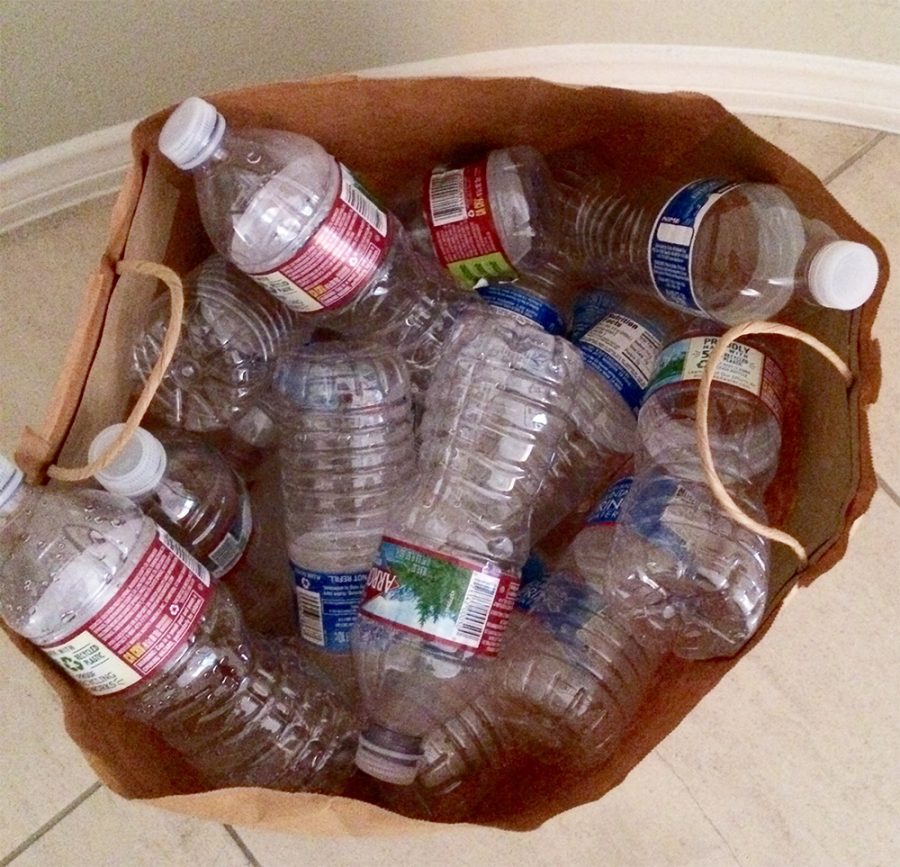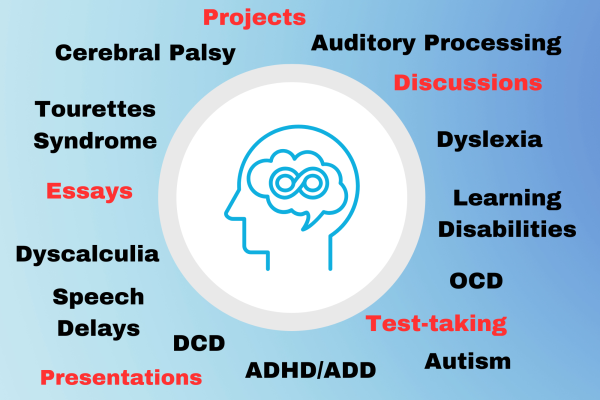Op-Ed: Plastic water bottles are destroying our health, planet
Photo credit: Maya Wernick
As much as I hate to admit it, pictured here is a bag of plastic water bottles that my family consumed in just a week. Action needs to be taken to limit our usage of plastic bottles, and if my family can do it, then anyone can.
Last year, it was estimated that the United States consumed 50 billion plastic water bottles.
This is a staggering amount, since the United States only makes up about 4.5 percent of the global population. Besides simply being wasteful, there are many negative aspects to using plastic water bottles, which can be eradicated with a few simple tweaks.
Firstly, the United States has a very low plastic recycling rate of 23 percent, which means that 38 billion water bottles are wasted each year, according to Ban the Bottle, an initiative striving to fight this preposterous consumption. This will impact the earth forever if it is not taken care of immediately and drastically.
America uses 17 million barrels of oil to make and keep up with the need for plastic bottles, which is enough to fuel about 1.3 million cars for an entire year, according to Jake Richardson from Blue Living Ideas. Additionally, plastic is made up of petroleum or natural gas, which are fossil fuels that contribute a great deal to our (very-real-not-a-hoax) climate change and the production also creates millions of tons of CO2 — not including all of the resources needed to ship and sell these bottles.
Norm Schriever of the Huffington Post describes plastic water bottles as “poisonous time bombs.” Water bottles are made of polyethylene terephthalate (PET) plastics, which photodegrade instead of biodegrade. This means that the bottles break down into smaller fragments over time instead of being put back into the earth.
These billions of fragments can take centuries to decompose, all while polluting and destroying our earth.
Also, the plastic bottle industry is one of the main contributors to “hidden water.” Hidden water refers to water that is used to make something that consumers are unable to see. For a bottle of water, the Pacific Institute “estimates that twice as much water is used in the production process. Thus, every liter sold represents three liters of water [used].” It is quite ironic that it takes more water to make the bottles than the amount of water that actually ends up in the bottle.
Despite all of these egregious environmental consequences to plastic bottles, there are many consequences that have direct impacts on everyday citizens.
For example, bottled water is more expensive than tap water, often by thousands of dollars. The daily recommended eight glasses of water a day costs less than $1 per year — at the average US tap water rate, whereas the equivalent amount in bottled water could be around $1,400, depending on the brand, according to Blue Living Ideas. To put this in perspective, “we complain incessantly about gas prices at $3.89 a gallon, but the same amount of San Pellegrino bottled water would cost close to $10,” Schriever wrote.
Many people believe that because bottled water goes through a filtration process that its taste is improved, but this is not necessarily true,
“While [filters] can reduce exposure to [harmful] elements, it doesn’t necessarily mean bottled water will be better for your overall health,” Katherine Patton said, a registered dietician and certified sports dietitian, said in an interview with CNN.
Tap water is actually safer to drink than bottled water. Water bottle companies such as Pepsi’s Aquafina and Coke’s Dasani have admitted to taking their water from municipal sources, which essentially means that bottled water is the same as tap water — but bottled water is not held to the same safety standards.
According to a study done at Case Western Reserve University, “five percent of the bottled water purchased in Cleveland fell within the required fluoride range recommended by the state, compared with 100% of the tap water samples, all of which were also within 0.04 mg/L of the optimal fluoride level of 1.00 mg/L. Use of bottled water based on the assumption of purity can be misguided.”
This shows that despite regulations, many bottled water companies are slacking in terms of their safety standards, and only have to test their water once a year, whereas tap water gets tested every week. Additionally, bottled water companies are not required to report their findings of their annual studies, while tap water findings are required to be released, which adds a layer of suspicion and mystery around bottled water production.
Sometimes though, this system fails, such as in Flint, MI, which has been without clean water since 2014, according to CNN. When Flint switched their water supply provider, they discovered that their water had been contaminated with lead and other bacterium. At first, this supposedly could have been solved by boiling all water, but it ultimately had serious health repercussions despite precautions. While this is rather disconcerting, this is one instance that needs to be taken care of, and does not reflect the sanitation of most municipal water sources.
Using plastic water bottles has serious consequences for the environment and human health. Action needs to be taken immediately.
Similar to the Plastic Bag Ban, where in 2014 California was the first state to enact legislation that created “a state-wide ban on single-use plastic bags at large retail stores,” and placed a 10 cent minimum charge for “recycled paper bags, reusable plastic bags, and compostable bags at certain locations,” a tax should be placed on plastic bottles.
A five cent tax should be imposed per plastic bottle in order to motivate people to think about their purchasing choices and hopefully exchange plastic bottles for reusable ones. As of now, California has a CRV tax, or California Refund Value, which refunds people 5 cents if they bring a plastic bottle to a recycling center. But, while this helps somewhat with the cost aspect of the bottles, it doesn’t help the wasteful culture of our country. Similarly, reusable bottles should be made cheaper, so more people would be inclined to buy those as a healthier, environmentally safer alternative.
Additionally, labels on plastic bottles should be required to list all of the potential health issues that could develop from drinking it. If people realize that these bottles are not only now more expensive, but also could possibly cause hair loss, kidney and liver problems, and even increase your risk of cancer, they will be deterred from buying these plastic poison time bombs.

Maya Wernick joined the Oracle in 2016 and became Voices Editor in 2017. She is a member of Archer’s Student Council, Model United Nations Club and is...











Amy Wernick • May 18, 2017 at 9:42 pm
This article is quite eye-opening and disturbing. You have convinced me to try to change my ways – reusable water bottles for the whole family!
Nelly Rouzroch • May 18, 2017 at 6:51 pm
Amazing article!
Sydney Shintani • May 18, 2017 at 4:47 pm
Wow Maya! This a very interesting and informative article. Thank you so much for sharing such an important issue!
Cat Oriel • May 18, 2017 at 4:47 pm
Dear Maya,
Thank you for this very powerful Op-ed. I agree- water bottles are very detrimental to our health and planet. I really liked how you described them as plastic poison time bombs. They must be stopped.